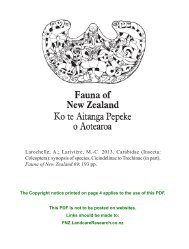Fauna of NZ 45 - Landcare Research
Fauna of NZ 45 - Landcare Research
Fauna of NZ 45 - Landcare Research
You also want an ePaper? Increase the reach of your titles
YUMPU automatically turns print PDFs into web optimized ePapers that Google loves.
36 Kuschel (2003): Nemonychidae, Belidae, Brentidae (Insecta: Coleoptera)<br />
as the rostrum. Eyes as far apart as they are from the<br />
thorax, prominent, subrotundate. Thorax truncate at base<br />
and apex, a little longer than broad, rounded, widest, and<br />
most convex at or before the middle, its basal half much<br />
constricted and depressed. Scutellum absent. Elytra oval,<br />
apparently truncate and <strong>of</strong> the same width as thorax at the<br />
base, about double its length and almost twice as broad and<br />
convex near the middle.’<br />
‘Scape inserted evidently before the middle, attaining<br />
the eye, moderately stout, subclavate at the extremity.<br />
Funiculus hairy, basal joint slightly longer than second and<br />
twice as thick; third at apex as broad as fourth, both together<br />
slightly longer than second; fifth to seventh transverse,<br />
seventh broadest; club abruptly enlarged, subovate,<br />
apparently triarticulate.’<br />
‘Legs elongate, simple. Tarsi elongate, second joint <strong>of</strong><br />
the anterior a little shorter than the basal, the third with<br />
long narrow lobes, fourth narrow, longer than the first.<br />
Underside dull, with a few slender grey hairs. Prosternum<br />
truncate in front, the coxae prominent, the intermediate<br />
also contiguous, the posterior distinctly separated. Basal<br />
two ventral segments apparently connate, large, third and<br />
fourth very short.’<br />
‘This remarkable little weevil disagrees with 828 [Apion<br />
metrosideros] in nearly all specific details <strong>of</strong> form and<br />
sculpture.’<br />
Length 1.3–1.5 mm.<br />
Type material. Holotype %, 1.5 x 0.70 mm, Pakarau [in<br />
error for Pekerau], no number [4312 in publication], 19<br />
May 1918, BMNH.<br />
Material examined. Holotype and 18 non-type specimens.<br />
North Island. ND. Te Paki Coastal Park, North<br />
Cape; Te Paki Trig; Kohuronaki; Pekerau (holotype);<br />
Butterfly Valley, Tauranga Bay; Mangamuka Saddle;<br />
Maungataniwha Range, Mangamuka saddle; Waipoua Forest;<br />
Waipoua, Toatoa site; Waipoua, Toronui Track; Waitangi<br />
State Forest. 19 specimens.<br />
Distribution. ND / –.<br />
Host plant. Unknown.<br />
Cecidophyus gen. nov.<br />
Fig. 12, 13, 122–136<br />
Type-species C. noth<strong>of</strong>agi spec. nov.<br />
Head elongate, behind eyes about twice as long as an anteroposterior<br />
diameter <strong>of</strong> eye, constricted at basal one-<br />
third or quarter, densely strigose across constriction, temples<br />
in front <strong>of</strong> constriction rugose, slightly rounded. Frons<br />
in male a little narrower, in female a little wider than rostral<br />
apex, shallowly depressed, with shallow median fovea.<br />
Eyes round, dorsoventral diameter less than an apical depth<br />
<strong>of</strong> rostrum, slightly more than depth <strong>of</strong> temples in male, a<br />
little less than depth <strong>of</strong> temples in female, coarsely facetted.<br />
Rostrum shorter than prothorax, straight, tapering towards<br />
antennal insertions, then cylindrical in male, slightly widening<br />
in female, not broader at antennal insertion point;<br />
epistome distinct, vertical, bifoveate; scrobes shallow, directed<br />
towards gular angle. Antenna (Fig. 127) inserting at<br />
rostral middle in male, a little behind middle in female,<br />
extending to anterior margin <strong>of</strong> prothorax, robust; scape<br />
reaching eyes, straight, weakly clavate; segment 1 <strong>of</strong> funicle<br />
longer than wide, segment 5 smaller than 4 or 6; club<br />
elongate, loosely segmented, segment 1 equal to one-third<br />
<strong>of</strong> club length.<br />
Prothorax longer than wide, with distinct apical collar<br />
on sides, rounded on sides, rounded <strong>of</strong>f at basal angles,<br />
truncate at base, without basal rim, in pr<strong>of</strong>ile moderately<br />
proclinate, 1.7x longer dorsally than ventrally. Scutellum<br />
large, triangular, gently ascending, with large impression.<br />
Elytra slightly widening to just passed the middle,<br />
independently rounded at apex, with humeral callus, with<br />
sloping basal declivity near scutellum, with vertical basal<br />
declivity towards sides not sinuous; longitudinal convexity<br />
gentle, transverse convexity pronounced; stria 10 at end<br />
shallow, very finely, indistinctly punctate; sutural stria<br />
slightly impressed from basal third to apex, more distinctly<br />
punctate than 10; striae 7 and 8 only briefly, if at all,<br />
coalescent at base. Interstriae slightly convex, sutural one<br />
flat at basal one-quarter, raised along stria. Vestiture<br />
consisting <strong>of</strong> sparse, short, and fine erect pilosity<br />
intermingled on interstriae 4–7 with usually longer sensory<br />
hairs. Inferolateral flange uninterruptedly continued to<br />
junction with stria 2. Hind wing largely as in Strobilobius,<br />
Fig. 130, but differing in having a small, lineal or narrowly<br />
elliptical radial window, a wide radial stripe behind R, a<br />
radiomedial sclerotisation merging with the radial stripe, a<br />
much more extensive pigmentation in the radial area <strong>of</strong> the<br />
apical field divided nearly all the way to the apex <strong>of</strong> the<br />
wing by a clear line that runs parallel with the anterior<br />
margin <strong>of</strong> the wing, and in having a uniformly wide,<br />
uninterrupted medial stripe and no pigmentation next to<br />
Cu.<br />
Mesepimeral suture deeply sulcate throughout; mesoand<br />
metasternal processes disjunct owing to coxae being<br />
contiguous. Process <strong>of</strong> ventrite 1 broadly truncate; first<br />
abdominal suture distinct, grooved on sides; ventrite 5 in<br />
male broadly truncate, not rimmed at apex, in female<br />
subtriangularly rounded, rimmed on sides and apex. Tergites
















